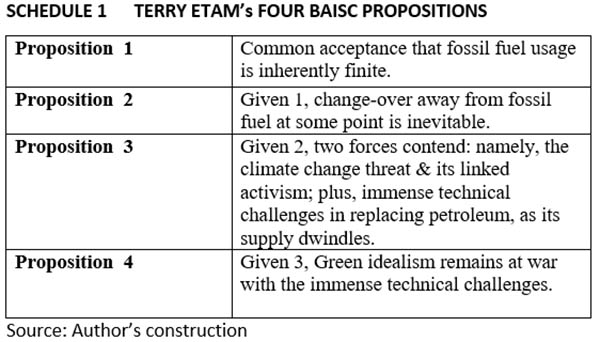Introduction
This week’s column wraps-up my assessment of Terry Etam’s book, which I began last week. There, in an admittedly heroic leap I had dared to reduce this book to encompassing four basic propositions as indicated in Schedule 1 below for reader’s convenience. Last week I had started to discuss Proposition 1 and I shall complete this task today, and then proceed to finalize my consideration of this text.
Proposition 1 cont’d
In last week’s column I had referenced the utter failure of Hubbert’s rather simplistic prediction (offered in the early 1970s) in regard to the timing of global and regional peak crude oil output. This was followed by several other failed predictions published over the several decades since. Indeed, I would venture the opinion that these predictions constitute an early segment of today’s doom and gloom purveyors in the energy sector worldwide. Such narratives are being actively revived consequent to the pandemic-induced slump in global crude oil demand in 2020. Neither Etam’s book nor the EIA Report considered thus far was influenced by the 2020 dramatic slump in global energy consumption, since both texts were published in 2020.
Readers may wonder, why have these predictions failed? The answer is two-fold. First, there has been a serious under-estimation of the countervailing forces at work. And, second, a willful or unaware mis-reading of basic economics. The countervailing forces include: technological breakthroughs, geopolitical developments, and pure serendipity. Developments in our neighborhood (Guyana-Suriname Basin and Venezuela) signify the massive impact of these forces.
Second, a fallacy has taken root. This fallacy asserts that, globally, crude oil resources must be 100 percent depleted, or colloquially, “run out,” before the world stops using it. However, basic economics teaches us that, as easily accessible petroleum reserves deplete, retrieving it gets costlier and its price rises. Faced with this occurrence, the use of alternative energy sources becomes more attractive and competitive if their prices decline relatively.
Proposition 2
Although clearly not camped out in the peak oil circuit, Terry Etam’s book fully acknowledges the certainty of the coming loss of the decades old crude oil dominance in satisfying global energy consumption. That loss of dominance will most likely be a gradual one. In the EIA Report, this is anticipated to take place circa 2050. Further, the transition to renewable sources leaves petroleum liquids growing positively, at an annual average of around 0.6 percent. As Etam puts it bluntly, today “the world’s reliance on fossil fuels has never been higher- global demand continues to climb.” He observes, regretfully though, that there is a lot of global chatter which seeks to deny and contradict this reality.
Etam also notes that the chatter is being fueled from several sources. These include: 1) media rhetoric; 2) government propaganda; 3) civil organizations and groups that could not survive due diligence; and worst of all 4) widespread ignorance. In turn, the chatter has created a false impression in regard to the practical requirements for petroleum replacement worldwide. Nonetheless, the transition from petroleum persists as two driving factors converge; namely, access to so-called cheap oil, and climate change effects.
It takes great realism in today’s contentious environment to arrive at the position that present day reliance on fossil fuels with further impetus being driven by the rising trajectory of global growth in real per capita GDP and, as a result, persistent rising demand for unsustainable energy is no longer a reasonable proposition in the foreseeable future. Given this, easy options for remedying this conundrum just no longer exist.
Proposition 3
Following the second proposition, the third advances the view that, going forward, conceptual and related policy-based solutions will remain deeply intertwined in conflicts. Such conflicts arise from the perceived existential threat posed by human-led climate change, as vociferously advanced by its activist base, on the one hand. And on the other hand, from the immense technical challenges posed in finding a competitive energy replacement for petroleum.
Etam is distrustful of today’s environmental activism. He finds media coverage is revealing that climate change activists are singularly simple minded and offering at best, a mystical green-energy paradise. At the same time, the on-going debates consistently overlook and/or understate the humongous technical challenges that must be overcome in finding a practical global replacement for fossil fuels.
Etam is crystal clear on four points. First, his stand is consistent with the EIA’s 2050 projections in that he expects the global consumption of fossil fuels to keep growing over the long-run. Second, he emphasises that such an outcome is an inevitable consequence of a basic consideration, which is people as a rule expect to be able to, at a very minimum, maintain their prevailing quality/standard of life. That minimum can be translated into their per capita GDP as it presently stands. This is typically the product of more than a century of economic growth energized by petroleum. Finally, if present day quality of life is intimately linked to petroleum-based energy, we cannot reasonably ignore technological developments and breakthroughs. Guyana’s off-shore world class finds is an example of this.
Proposition 4
Essentially Etam’s ‘fossil fuel insanity” is exemplified in the naivete and foolishness exemplified in the public debates. This strongly correlates with the term I routinely apply “noise and nonsense”. And the warring groups at the global level have their local counterparts around the world, including here in Guyana. These too engage in fruitless and endless debates. The sad truth is that ending fossil fuel threats in Guyana without any alternative development trajectory and programme is equally reckless and against the interests of the poor and powerless.
Conclusion
Next week I shift to the next book after a few wrap-up comments on Etam’s.







